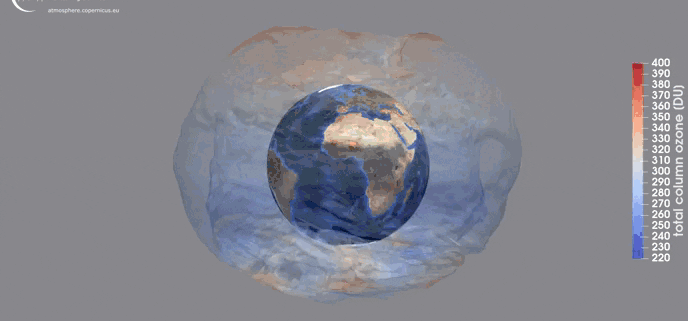Copernicus: Unusually persistent Antarctic ozone holes in 2020-2022
Copernicus: Unusually persistent Antarctic ozone holes in 2020-2022
 Data from the Copernicus Atmosphere Monitoring Service (CAMS) on the closing of the 2022 Antarctic ozone hole highlights some unusual behaviour. Not only did the closure of the ozone hole take longer than usual, but it was relatively large. This is particularly remarkable given that this behaviour is not unique to this year, but it is similar to ozone holes of 2020 and 2021 and differs from what had been observed in the previous 40 years.
Data from the Copernicus Atmosphere Monitoring Service (CAMS) on the closing of the 2022 Antarctic ozone hole highlights some unusual behaviour. Not only did the closure of the ozone hole take longer than usual, but it was relatively large. This is particularly remarkable given that this behaviour is not unique to this year, but it is similar to ozone holes of 2020 and 2021 and differs from what had been observed in the previous 40 years.
The Antarctic ozone hole usually starts opening during the Southern Hemisphere spring (in late September) and begins to decline during October, before typically coming to an end during November. Nonetheless, the CAMS data from the last three years show a different behaviour: during this time, the ozone hole has remained larger than usual throughout November and coming to an end well into December. More detailed information is available in the article: Three peculiar Antarctic ozone hole seasons in a row: what we know.
3D development of the Antarctic ozone hole up to 13 December 2022. Animations for 2017 to 2022 can be found on the CAMS ‘monitoring of the ozone layer’ webpage. Credit: Copernicus Atmosphere Monitoring Service, ECMWF
3D development of the Antarctic ozone hole up to 13 December 2022. Animations for 2017 to 2022 can be found on the CAMS ‘monitoring of the ozone layer’ webpage. Credit: Copernicus Atmosphere Monitoring Service, ECMWF
As for the causes of this new behaviour CAMS Director, Vincent-Henri Peuch explains: “There are several factors influencing the extent and duration of the ozone hole each year, particularly the strength of the Polar vortex and the temperatures in the stratosphere. The last three years have been marked by strong vortices and low temperatures, which has led to consecutive large and long-lasting ozone hole episodes. There is a possible connection with climate change, which tends to cool the stratosphere. It is quite unexpected though to see three unusual ozone holes in a row. It is certainly something to look into further.”
The date of the ozone hole closure in 2020 and 2021 was 28th December and 23rd December respectively, and scientists expect that this year’s hole will close within the coming days.
The last three ozone holes have been not only exceptionally persistent, but also had a relatively large extension. During these three years the ozone hole has been above the 15 million km2 (similar to the size of Antarctica) during most of November.
Heatmap showing the extent of each Antarctic ozone hole below the 60th parallel south since 1979 and the date. The last seasons have been unusually long. (Data for 2022 is recorded until 07 December) Credit: CAMS
Heatmap showing the extent of each Antarctic ozone hole below the 60th parallel south since 1979 and the date. The last seasons have been unusually long. (Data for 2022 is recorded until 07 December) Credit: CAMS
However, despite these recent fairly large ozone holes, there are consistent signs of improvement of the ozone layer. Thanks to the implementation of the Montreal Protocol, the concentrations of Ozone Depleting Substances (ODS) have been slowly but steadily declining since the late nineties. It is expected that in 50 years their concentrations in the stratosphere will have returned to the pre-industrial levels and ozone holes will no longer be experienced regardless of Polar vortex and temperature conditions.
Details
Publication status:
Press releases – Climate Change
Date:
15th December 2022
Journal/Source:
Copernicus Atmosphere Monitoring Service (CAMS) / www.atmosphere.copernicus.eu




Leave a Reply
Want to join the discussion?Feel free to contribute!